
Booze, Sailors & Health Menu: 1 2 3 4 5 6 7 8 9 10 11 12 13 14 15 16 17 18 19 Next>>
Booze, Sailors, Pirates and Health In the Golden Age of Piracy, Page 13
Alcohol and Sailors
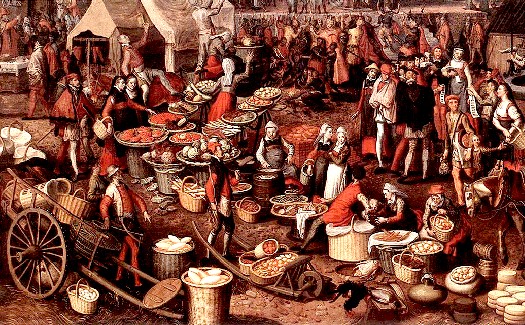
Artist: Pieter Aertsen - Market Scene (1550)
Sailors and alcohol have gone together since the earliest periods of history at sea. In his book about the history of the Royal Navy, William Laird Clowes notes that in the early 11th century, there was already "much trade [between England and] the continent in wool, cloth, wine, and fish."1 Goods such as these would be shipped from the producers in one shore-based town to market places in another. Wine was also made available to crews as early as the 12th century. Clowes explains that trading sailors on ships coming from Brittany, France "had beverage [wine] going and coming; but those of Normandy were to have two meals, because they had only water as the ship's allowance. As soon as the ship arrived in a wine country, the master was, however, to procure them wine."2 So merchant sailors would have been accustomed to having alcohol made available to them.
Artist: Eva Kröcher
Cog Ship Reconstruction - The Roland von Bremen, Dated to ~1380
Alcohol for the English naval forces dates at least back to the Battle of Sluys in 1340. King Edward III requisitioned English merchant vessels called 'cogs' to fight on his behalf against the French fleet who nearly decimated them on June 24th. Following the battle, "provisions and
wine were ordered for the refreshment of the fleet."3
Since wine was a foreign product, and thus more expensive, it eventually gave way to English beer. By 1582, the Elizabethan navy "were provided for every mess of four men, for 28 days, one pipe of beer, 112 lb. of salt beef or pickled meats, 128lb. of biscuit, 70 lb. of salt fish, butter and cheese, and 500 lb. of wood and water, all of which occupied one ton of stowage."4 By 1590, the Royal Navy had set the sailor's daily ration of beer to a gallon a day which was to be given out at meals.5 Ian Williams suggests that this was because the water went bad on long voyages where beer would not, his argument being built upon published complaints about the water on naval ships. However, such complaints are actually fairly rare given the large number of ships and time span under consideration. Although they can't be entirely dismissed, it is doubtful that the majority period opinion was that beer was needed to replace water for any reason other than the most obvious one: sailors were used to it and, not surprisingly, preferred it.
We know Italian explorer Christopher Columbus took wine with him on his first voyage to the West Indies because there was nothing left on the return trip "but bread and wine, and some yams from the Indies."6 This wine had been brought aboard in barrels; when they ran out of supplies, Columbus' journal notes that "[t]he only
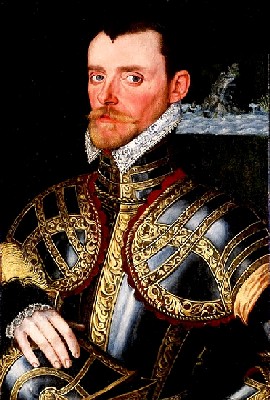
Richard Hawkins (1600)
thing to do was to fill the barrels that had contained wine or fresh water with water from the sea"7.
While in Teneriffe, Canary Islands in 1564, privateer Sir John Hawkins noted that "they make wine better than any in Spain, they have grapes of such bigness that they maybe compared to damsons [plums], and in taste inferior to none."8 In the same account, Hawkins mentions 'palmito [palm] wine' which he explains was "divided part and portionlike to every man by the judgment of the captain and elders, every man holdeth himself contented."9
Another Hawkins, John's son Richard, gave an account of a voyage taken to the West Indies in 1593 where scurvy ravaged the crew. Part of his antidote was "at discharge of the watch, to give every man a bit of bread, and a draught of drinke, either beere or wine mingled with water (at the least, the one halfe), or a quantitie mingled with beere, that the pores of the bodie may be full"10. Although his medical diagnosis was suspect, this may be the first recorded instance of watered-down 'beverage wine' on an English ship.
These examples only touch upon alcohol consumption by sailors throughout history. There are a large number of other historic examples which could be cited here, but the point is that alcohol on voyages was expected by the common sailor because merchant, exploratory and privateering sailors were given such beverages during their voyages. Recall that the East India Company sailors played a pivotal role in the spread of punch with one author arguing that a sailor may have been its originator in the early 17th century.
With this in mind, this section of the article will look at some facets of alcohol in the sailing community during the golden age of piracy. It begins with a brief look at how sailors used alcohol when in port, followed by how alcohol was used by sailors in both celebrations and toasts and ways alcohol was employed in business transactions conducted by captains and company factors (buyers). Ways which the three broad types of sailors discussed in this article consumed alcohol is then discussed, which is divided into naval sailors, merchant and privateer sailors and, finally, pirates.
1 William Laird Clowes, The Royal Navy A History, 1897, Volume 1, p. 19; 2 Clowes, p. 108; 3 Clowes, p. 255; 4 The English Historical Review, Vol. VI, 1891, p. 479; 5 Ian Williams, Rum, 2006, p. 230; 6 Steven Kreis, Journal of the First Voyage of Christopher Columbus, Document No. AJ-061, Wisconsin Historical Society, p. 233; 7 Journal of the First Voyage of Columbus, p. 240; 8 John Spare, "Hawkins - Second Voyage", Voyages of the Elizabethan Seamen, Edward John Payne, ed., 1907, p. 13; 9 Spare, p. 21; 10 Richard Hawkins, The Observations of Sir Richard Hawkins, Knt, Hakluyt, 1847, p. 59
Alcohol and Sailors: In Port
"We were all of us too wild and little considered the mercies we received, but took large liberty when ashore in drinking and sporting as the manner of seamen generally is." (Edward Coxere, Adventures by Sea of Edward Coxere, 1946, p. 40)
Upon reaching port, many of the golden age of piracy accounts note that the average sailor headed for a bar. Recall that William Dampier said in 1691 that "the Punch-houses were never empty" on the East India's 'refreshing island' of St Helena.1 Several other authors explained it in even more direct terms. Navy clerk John Baltharpe said in his poem about the journey of the St. David that when "A Seaman when he gets Ashoar,/
In one days time he spendeth more; / Then three months short-allowance Money"2. (As mentioned previously, short allowance money was paid to navy sailors for every three months they were in a foreign port.)
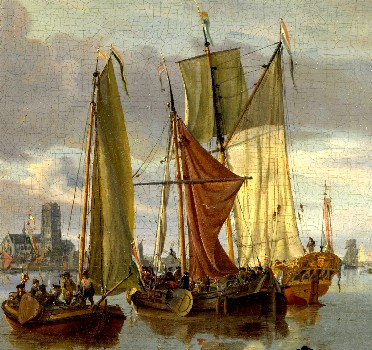
Artist: Abraham Storck -
Ships in Port in the River (c. 1690-1700)
Always one to complain about perceived injustice, sailor Edward Barlow explained in 1668 that when a ship reached port,
the poor seamen, wanting money, go to the purser and then take up such clothes as they think will yield the most money, setting their hand to the purser’s book to pay at pay-day ten shillings for that which costeth in England seven, and going ashore with it sell it to the Spaniard or to any other people where they are, for four or five shillings, many taking up all their wages in this manner... and this they will do many times for a cup of good drink, for they seldom get any good victuals.3
Barlow is talking about the 'slop chest' which contained clothes that the sailors could buy on credit, which they were supposed to do when their own clothes were no longer serviceable. Barlow is saying that when a ship reached port, the sailors would buy these clothes not for themselves, but to sell them in the port for half or less what they paid for them so they had money to spend on drink. Barlow doesn't have a lot of good things to say about ship's pursers (as seen previously in the section on beverage wine), but it seems a little disingenuous to blame the man for selling extra clothes to sailors who turned around and sold them at a loss just to pay for drinks in ports. It does, however, emphasize how badly they wanted to buy booze when they reached land.
The officers weren't much different, although they tended to dine with local dignitaries and drink a better class of alcohol. Chaplain Henry Teonge mentions a number of instances where he or other officers went ashore to eat and drink with such men in several countries. Teonge spent most of the months of April and May of 1676 roaming about Turkey while the HMS Assistance was anchored along the coast. He attended several dinners and feasts where he drank a variety of beverages, primarily different types of wine. Because his hosts were of the upper class, the provided their dinners with "greate plenty of all sorts of wine"4, "exceeding good wines of severall sorts"5, and "good canary--a greate rareity there, for it coms all from England."6 He apparently thought a great deal of the wine at Cypress as noted previously, for there he bought some to bring home with him.7
One good thing about being in foreign ports was
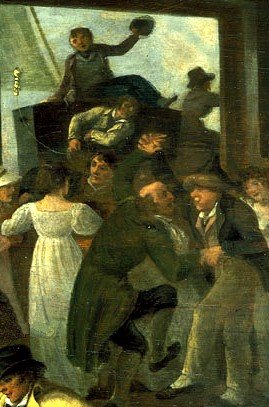
Artist: Julius Caeser Ibbetson
Sailors Carousing in a Tavern in Portsmouth (1794)
that the local beverage was usually pretty cheap and easy to get. Since many naval vessels were located in the Mediterranean, good wine could be had when a naval vessel stopped at ports in France and Spain. Barlow says that when they stopped in Marseilles in 1675, he and his shipmates "called for a cup of wine to make ourselves drink, for they have very good wine and cheaper than good beer in England, and the Frenchmen that were passengers made all of us drink very freely."8 While in Malaga, Spain to get water for their vessel, Barlow reported that the navy men stopped to have some of the local wine "till some of our company were almost drunk: for we had it cheap enough, giving but threepence halfpenny and a groat for a quart of good ‘Malego sack’. And I for my part drank very heartily, for it was very sweet and good, and I was not used to drink such every day"9.
John Baltharpe reports on the alcohol navy sailors found in a variety of different Mediterranean ports during HMS St. David's journey. In Alicante, Spain he reported that they drank the local wine which he called the 'blood of Bulls' until they could barely stand, explaining that "The Bottle is not long a emptying:/ When that is out, we'l fill another,/ When that is gone, we must have tother."10 In Naples, Italy, "each man did a Dollar get,/ But we did buy no Lands with it;/ Old trade it did proceed a pace,/ Some were half drunk for three days space:/ The Wine was cheap, and very good,/ It chear'd our hearts, and warm'd our blood"11.
Even when the ships were anchored off shore and the men weren't able to go into town, alcohol was sometimes brought out to them. Baltharpe explains that while anchored off Rota, Spain in the Bay of Bulls in 1669,
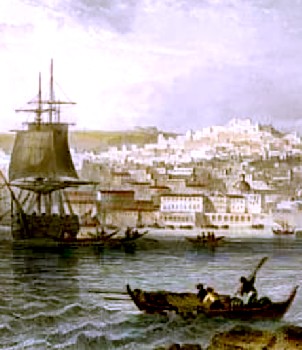
Going Out to a Ship, Port of Algeria (18th/19th c.)
The Spaniards brought us Wine A-board,
Bread, Grapes, Fig-cheeses they aford
Either for Money or Truckar [trade];
For six Royals they I sell a Jarr [of wine],
They'l bargin make Wino per te;
Again reply Jarro per me:
They ply'd their business very close,
Most of our men they got a doss [dose];
Next day before that it was night,
Some of our Men were drunk out right.12
While anchored off Malaga, Spain the next year they sent their boat ashore, "And Sack she brought Aboard good store:/ That night there was some drunk, some sober,/ And some were also half Seas over"13. Henry Teonge mentions that although the men on the HMS Bristol weren't given pratique (clearance to go ashore) in December of 1678, the people of the town of Almeria, Spain "brought to us good wine, lemons, oringes, pom-cytrons [probably pomegranates], sheepe, henns, eggs, coleworts, &c. and sould them cheape enough."14
The trading and privateering ships also made sure to sample the local alcohols while in port. Francis Rogers said that while their merchant vessel was in Sually [modern Dumas, India] the local Parsis sold "punch, toddy [palm wine] and liquors for the sailors"15. In Surat, India, he noted that while on shore, "The chief liquors drank by us are punch and Shiras wine, a very strong pale red wine made in Persia, sometimes English beer and French wine."16
Trader William Snelgrave reported that while he was making arrangements to obtain slaves from an African king he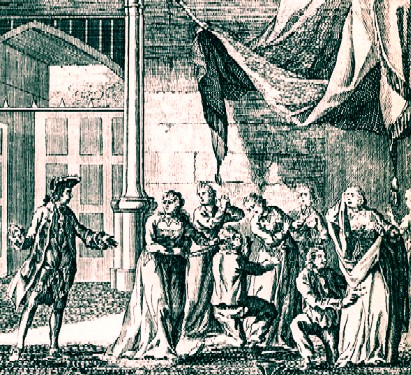
Woodes Rogers & His Men Collecting Jewelry in Guayaquil (18th Century)
avoided drinking the arrack because it didn't agree with him. His men, however, "did not spare it, drinking plentifully of it with his [the African King's] Guards"17. And, lest we forget, some of privateer Woodes Rogers' men "were hugging each other [when they reached Batavia [modern Jakarta], others blessing themselves that they were come to such a glorious Place for Punch, where they could have Arack for 8 Pence per Gallon, and Sugar for 1 Peny a Pound"18.
Of course, there were health consequences to this. When they stopped at Guayaquil, Ecuador, Rogers sagely noted "we knew that Misfortunes attend Sailors when out of their Element"19. Sea surgeon John Atkins said that one of the problems with making landfall from a medical perspective was that "Seamen do greedily purchase any thing to eat or drink, that is the Produce of the Country, without regard to the Wholesomeness or Alteration of their Way of Diet; on both which Respects due Caution ought to be had; that the Shores become in general more pernicious to the Healths of Europeans, than the Sea, where those Inconveniences are better avoided."20 Even so, the evidence clearly shows that Atkins advice was largely ignored while in port.
1 William Dampier, Memoirs of a Buccaneer, Dampier’s New Voyage Round the World -1697-, 1968, p. 365; 2 John Baltharpe, The straights voyage, or, St. Davids poem, 1671, p. 15; 3 Edward Barlow, Barlow’s Journal of his Life at Sea in King’s Ships, East and West Indiamen & Other Merchantman From 1659 to 1703, p. 151-2; 4 Henry Teonge, The Diary of Henry Teonge, Chaplain on Board H.M.’s Ships Assistance, Bristol, and Royal Oak, 1675-1679, 1825, p. 160; 5 Teonge, p. 165; 6 Teonge, p. 187; 7 Teonge, p. 188; 8 Barlow, p. 270; 9 Barlow, p. 52; 10 Baltharpe, p. 53; 11 Baltharpe, p. 61; 12 Baltharpe, p. 14; 13 Baltharpe, p. 52; 14 Teonge, p. 268; 15 Francis Rogers, From Bruce S. Ingram's book Three Sea Journals of Stuart Times, 1936, p. 180; 16 Francis Rogers, p. 182; 17 William Snelgrave, "Introduction", A New Account of Some Parts of Guinea, 1724, not paginated; 18 Woodes Rogers, A Cruising Voyage Round the World, 1712, p. 390; 19 Woodes Rogers, p. 154; 20 John Atkins, The Navy Surgeon, 1742, p. 353
Alcohol and Sailors: Problems for Pirates Trying to Make Port
Pirates had a harder time finding ports where they would not be discovered and put in jail or hung, so there are fewer accounts of them making their way to larger, civilized ports and drinking the beverages in the local establishments. Of course, it must be noted that most of the accounts of pirates are told by court trial witnesses or victims which tend to focus on their more outrageous acts. As a result, it is impossible to say how many times they successfully managed to blend in with the local populace and enjoy the local taverns. However, there are a variety of accounts showing them failing to do so.
Sometimes the problem for pirates coming to a civilized port was the ship itself. After taking several ships in the East Indies, Henry Every stopped at the friendly, but largely uncivilized (by contemporary English standards) Madagascar, moving on to 'the newly settled' island of Providence in the Bahamas. Wanting to return to the Colonies with their treasure Every
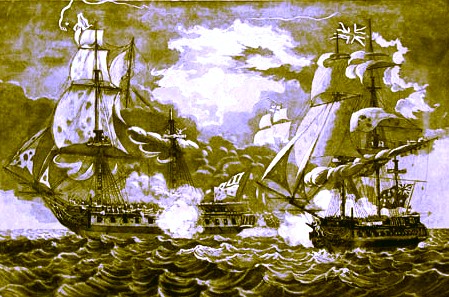
English Razee Frigate Indefatigable Attacking the French Frigate Virginie (1796)
worried that "the Greatness of their Ship would cause much inquiry about them; and possibly some People from England... might suspect them to be the People [mutineers], they therefore took a Resolution of disposing of their Ship at Providence"1.
Pirate ships had certain characteristics that made them recognizable to those familiar with the sailing culture. Writing about an attack by pirates in 1686, Richard Salway explained that they "made use of our Prospective Glass to discover what she [a ship seen coming up to them] was, with which at last We perceived their ship to row with 12 oars on a side or more. We then being confirmed in our opinion that he was a Rogue (i.e., a Pirate) made ready to receive him as such."2
Large numbers of men on deck and razees - ships where extraneous decks, buildings and other structures had been removed to make the ship lighter and faster - also suggested that what might be pretending to be a merchant ship was actually a pirate. In 1697, the men on the East Indiaman Dorrill spied a ship coming towards them which they first took to be a Dutch trading ship heading for an Indian port. However, "when we perceived she had no Gallerys [walkways along the outside of the quarterdeck], and then [we] suppose[d] her to be what after, to our dreadful sorrow, [we] found her [to be]" - Robert Culliford's pirate ship Mocha.3 They later note that the pirates had put gun ports with brass cannons in where the galleries had been. As George Lowther's men prepared their ship for pirating, the "knocked down the Cabins, made the ship flush fore and aft"4. Upon taking a suitable ship, Bartholomew Roberts' men similarly "fell to making such Alterations as might fit her for a Sea-Rover, pulling down her Bulk-Heads, and making her flush, so that she became, in all Respects, as compleat a Ship for their Purpose, as any they could have found"5.
Other times the problem was the men themselves. When a group of Walter Kennedy's men made their way to Ireland, most of them "alarm'd the Country where-ever they came, drinking and roaring at such a Rate... squandering their Money away"6. Their behavior resulted in some being killed for their money, while others' "Extravagant way of living soon discovered [revealed that]
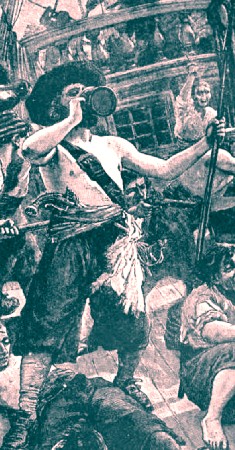
Artist: Amedee Forestier
They Stopped Only To Drink, From The world
went
very well then, By Walter Besant (1888)
they were not Passengers from London, as they pretended, but rather Pyrates, accordingly, they were taken up and Commited on Suspicion, as such, to the County Goal."7
After Edward Teach had captured several vessels in the bay of Charleston, South Carolina, he sent a group of pirates led by the a Captain Richards, (he was captain of Teach's consort sloop, the Revenge) into town along with Mr. Marks, one of the local town elders to make ransom demands. While Marks was talking with the town council, "Richards and the rest of the Pyrates, walk'd the Streets publickly, in Sight of all People, who were fired with the utmost Indignation" at the sight of them.8 Granted, this may have had a lot to do with their bottling up the Charleston harbor so they could demand medicines as ransom, but it hints at the troubles pirates had in regular towns.
When Howell Davis stopped for water at Santiago, one of the Cape Verde Islands,
the Governor, with some Attendants came himself and examined who they were, and whence they came? And not liking Davis’s Account of himself, the Governor was so plain to tell them, he suspected them to be Pyrates.Davis seemed mightily affronted, standing much upon his Honour, replying to the Governor, he scorn’d his Words; however, as soon as his Back was turn’d, for fear of Accidents, he got on board again as fast as he could.9
When pirates did want to enter civilized places, they often had to disguise themselves. After the debacle at the watering site in Santiago, Davis decided to try and take Gambia Castle in Africa. He went to a great deal of trouble to disguise his ship and her men make it work. Davis
ordered all his Men under Deck, except as many as were absolutely necessary for working the Ship, that those from the Fort seeing a Ship with so few Hands, might have no Suspicion of her being any other than a trading Vessel; then he ran close under the Fort, and there cast Anchor; and having ordered out the Boat, he commanded six Men in her, in old ordinary Jackets, while he himself, with the Master and Doctor, dressed themselves like Gentlemen; his Design being, that the Men should look like common Sailors, and they like Merchants. In rowing ashore he gave his Men Instructions what to say, in Case any Questions should be asked them.10
This worked for a day; the governor invited them to dinner and the pirates managed to sneak weapons in under their jackets and take the fort.
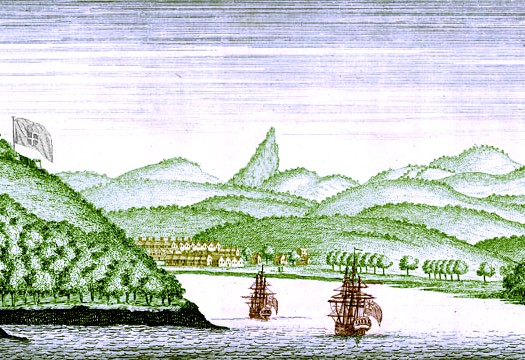
Ships Entering the Harbor at Principe Island (1727 )
Davis enacted a similar scheme at Principe Island and was once again able to fool the populace for a short time, despite his attempt to sneak ashore with fourteen men to rape some of the local women one evening. Unfortunately, a Portuguese man on Davis' ship " swam ashore in the Night, and discovered the whole Plot to the Governor, and also let him know, that it was Davis who had made the Attempt upon their Wives."11 After learning of this, the governor allowed the pirates to return to his house, but upon their arriving, "a whole Volley was fired upon them; they every Man dropp’d, except one, this one fled back, and escaped into the Boat"12. Davis was killed.
Edward Low's consort ship used a similar ruse in São Miguel, Azores where they tried to "pass for a Trader; but they play’d their Parts so aukwardly that they were suspected by the Governor to be what they really were, and he was soon put out of doubt by a Visit some Portuguese made them... upon which the whole Crew was conducted into the Castle, where they were provided for as long as they liv’d."13
After a group of mutineers led by John Smith mutinied and took their ship, they went to the Madeiras Islands to try and get some water and wine. They anchored off shore, "sending their Boat in towards the Shore, arm’d, to try if they could not board one of the Ships and bring her off; but they rendering themselves suspected by their Manner of working, found no Opportunity to put their Designs in Practice."14
There are accounts of pirates landing in less inhabited places that were friendly to them so they could enjoy what they had taken. Alcohol was a major component of this enjoyment. Captain Charles Johnson notes that Bartholomew Roberts crew stopped in Calabar, Nigeria where "they sat easy, and divided the Fruits of their dishonest Industry, and drank and drove Care away."15 George Lowther's men spent a winter in 'an Inlet somewhere in North-Carolina'
Thomas Anstis' Crew Holding a Mock Trail
From the Lauinger Library Collection ah
Georgetown
University
where, although it doesn't mention what they drank, they hunted cattle and hogs for food "and shifted as well as they could"16. Stede Bonnett's ship the Royal James was parked for two months in the Cape Fear River in South Carolina while they repaired it where they no doubt partook of the cargo of rum they had captured the month before.17 While waiting to find out if a letter they wrote asking for pardon would be granted, Thomas Anstis' crew spent nine months on an uninhabited island 'off the South-west end of Cuba' (possibly Isla de Juventud) where they "pass'd their Time... in Dancing, and other Diversions, agreeable to these Sorts of Folks"18. (They notably did not have rum, a fact which they complained about during a mock trial they held on the island.)
Of all the locations which were safe to pirates during this period, Madagascar seems to have held preeminence. It was so well known as a pirate hangout that several traders brought alcohols there to sell to the encamped pirates, who would pay exorbitant sums from their plunder for the privilege. A Captain Jacobs brought rum, wine and beer to St. Mary's for Adam Baldridge's trading post, where it sold it for increasing amounts as the supply dwindled. (For example, rum started at three pieces of eight per gallon, increasing to three and a half, then four and finally five.19)
Similarly, a merchant ship named the Neptune arrived in Madagascar where "having many Necessaries, French Brandy, Madera Wine, and English Stout on board, Captain Miller thought it better to trade for Money than Slaves."20 Another merchant ship named the Greyhound was there, also selling alcohols, which the pirates happily purchased with their treasure... until they didn't. After a few days of 'legal' buying of the alcohol from the two ships,
the Pyrates mann’d the Neptune’s Pinnace, seized the Greyhound, took away all the Money they had paid and shifting out of the Neptune ten Pipes of Madera [wine], with two Hogsheads of Brandy, into the Greyhound, and putting on board the Captain, second Mate, Boatswain and Gunner of the Neptune, and about 14 of her Hands, ordered her [the Greyhound] to Sea; the rest of the Neptune’s Company being young Men fit for their Purpose, they detained, most of which, by hard drinking, fell into Distempers and died.21
Making landfall could be tough on sailors, even pirates.
1 Daniel Defoe (Captain Charles Johnson), A General History of the Pyrates, Manuel Schonhorn, ed., 1999, p. 55; 2 Richard Salway, “A Fight at ‘Close Quarters,’ 1686”, The Indian Antiquary, S. Charles Hill, ed., November 1919, p. 199; 3 Solomon Lloyd and William Reynolds, “Letter from Solomon Lloyd and William Reynolds to his Excellency Sir John Gayes &c Freighters of ship Dorrill, dated Achin 28 August 1697”, The Indian Antiquary, S. Charles Hill, ed., Volume XLIX, 1920, p. 4; 4 Defoe (Captain Charles Johnson), p. 307; 5 Defoe (Captain Charles Johnson), p. 229; 6 Defoe (Captain Charles Johnson), p. 209; 7 The American Weekly Mercury, Thursday March 17th, 1720; 8 Defoe (Captain Charles Johnson), p. 74; 9 Defoe (Captain Charles Johnson), p. 170; 10 Defoe (Captain Charles Johnson), p. 171; 11 Defoe (Captain Charles Johnson), p. 192; 12 Defoe (Captain Charles Johnson), p. 193; 13 Defoe (Captain Charles Johnson), p. 325; 14 Defoe (Captain Charles Johnson), p. 361; 15 Defoe (Captain Charles Johnson), p. 229; 16 Defoe (Captain Charles Johnson), p. 315; 17 Defoe (Captain Charles Johnson), p. 99; 18 Defoe (Captain Charles Johnson), p. 292; 19 Ed Fox, “67. Prices of Pirate Supplies: A List of the Prices that Capt. Jacobs sold Licquors and other Goods att, at St. Mary’s, 9 June, 1698…”, Pirates in Their Own Words, 2014, p. 362; 20 Defoe (Captain Charles Johnson), p. 469; 21 Defoe (Captain Charles Johnson), p. 470

